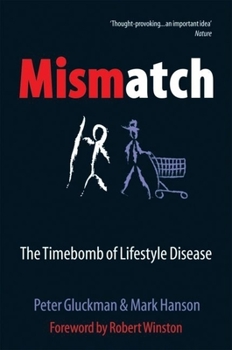Mismatch: The Lifestyle Diseases Timebomb
Select Format
Select Condition 
Book Overview
Our bodies and body processes evolved to allow our ancestors the best chance of survival as hunter-gatherers in the Savannah. Our brains, on the other hand, have evolved intelligence, imagination, and... This description may be from another edition of this product.
Format:Paperback
Language:English
ISBN:0199228388
ISBN13:9780199228386
Release Date:April 2008
Publisher:Oxford University Press, USA
Length:285 Pages
Weight:0.60 lbs.
Dimensions:0.8" x 5.1" x 7.8"
Related Subjects
Anatomy Anatomy & Physiology Anthropology Biological Sciences Biology Biology & Life Sciences Clinical Clinical Chemistry Ecology Evolution Health, Fitness & Dieting Health, Fitness & Dieting Internal Medicine Math Mathematics Medicine Politics & Social Sciences Reference Science Science & Math Science & Scientists Science & Technology Social Science Social SciencesCustomer Reviews
3 ratings
the importance of developmental plasticity
Published by Thriftbooks.com User , 17 years ago
The book is in two parts. The first deals with matching. With gens and developmental plasticity an organism tries to achieve a better match to its environment. The second part informs us about three main mismatches; the maturational mismatch which is increasing gap between physical maturation and psychosocial maturation, mismatched metabolism resulting in metabolic syndrome and mismatch between our inbuilt repair mechanism and our life course. The authors explain their thoughts with good examples and concepts. Methylated genes, life-history strategy, metabolic syndrome, developmental plasticity, physical and psychosocial maturation are some of the concepts I derived much benefit. The notes given at the end of the book are also important and should be read. The book make me aware of the problems we face and arouse my curiosity to delve further into the relating subject.
Our Bodies Fit the Ancient African Savannah, I Don't Live There
Published by Thriftbooks.com User , 17 years ago
The evidence is pretty overwhelming that we developed as humans in the African Savannah. The anthropologists point out how our bodies developed over the millennia to have a lot of characteristics that helped to enable, even guarantee our survival in that environment. There are numerous books that talk about our special adaptations: no hair ('The Naked Ape' Desmond Morris) so we wouldn't overheat while running, males with eyes optimized to detect movement of game while hunting, females with a thousand times better color sensitivity to detect the ripe fruit from the others. All this doesn't fit very well with my day of sitting staring at the computer screen, my neighbor's driving a truck, or nearly any of today's ways of earning a living. Yup! There's a mismatch. The authors do an excellent job of point out our world no longer fit our bodies. This is an insight that we ignore at our peril. They also point out some of the things that humankind might do to change the situation -- but BOY! is their solution going to offend some of the religious fundamentalists. Then again, wouldn't you want your children to be a better match for their society: slimmer, smarter, free from diabetes, cancer, heart disease?
Modern Man is in Trouble
Published by Thriftbooks.com User , 17 years ago
This is a very interesting and easy to read book. Gluckman and Hanson have managed in less than three hundred pages to explain the consequences of our man-made world not longer being appropriate for the biology we evolved with. They have done so using ideas from evolutionary biology, developmental science and medicine and show an understanding of environmental change and use examples that make this book equally appealing to the technically interested and the absolutely lay reader. The book is in two parts - the first part is about the science and the second part is about the consequences for human health and disease. Both are filled with examples and there is not much technical language. There are no chapters I found too challenging for a lay reader. In the second part of the book they use three major illustrations; puberty aging and the menopause and obesity/diabetes. I particularly found their insights into adolescence and puberty refreshing and challenging. The concept that the age of puberty may be returning to an younger age set by evolution, while the age of psychological maturation has moved in the opposite directions changes how one thinks about adolescence and has profound implications - parents, politicians and educators should read chapter 7. Their ideas on the role of foetal development in determining why some individuals are more at risk of diabetes and obesity creates a much more balanced perspective than purely genetic perspectives have led us into. The implications for how to stop the obesity epidemic and the need for different strategies in different populations are most thought provoking and compelling. But it is not just the specifics of these examples that makes this book so interesting. It is full of information from comparative biology, evolutionary biology, developmental biology, medicine and social science and it is the way they have combined these and produced a lucid and I think very important book. They are clearly scholars but scholars who can write in a very accessible way. They marry evolutionary biology and medicine in a much more complete and realistic way that previous attempts. And the sociological and associated commentary shows how much they have thought about the subject - the notes are quite fun too. If you are the kind of person who enjoyed Bill Bryson's Short History or Jared diamond's Guns Germs and Steal you will enjoy this book - it will leave you thinking.




